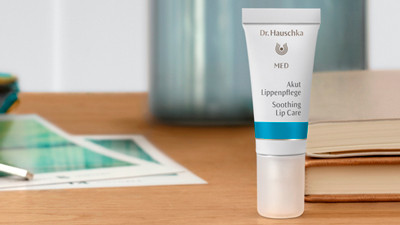Cold sores
What can be done to prevent dry lips and cold sores?
Various factors can put a strain on the sensitive skin of the lips, causing it to dry out and crack at the corners of the mouth. Many people also experience a tight, tingling sensation in the lips at this time, which is often followed by the appearance of blisters on or around the lips. These blisters can be painful and are prone to burst.
Applying a high-quality lip care product makes this delicate skin more resistant to environmental influences. Richly nourished, the lips stay supple and do not crack. Dr. Hauschka MED Soothing Lip Care was developed to meet the particular needs of lips that are prone to cold sores. The unique formulation is composed of purely natural ingredients with beneficial properties that take effect immediately. The central ingredients in the cooling Soothing Lip Care are the valuable freshly pressed juices of calendula and purple coneflower. Both these medicinal plants are known to prevent inflammation and promote regeneration. These ingredients are supplemented by nourishing Jojoba oil, stabilising sage essence, and cooling peppermint oil.
Regular application of Soothing Lip Care while the lips are healthy keeps the skin soft and supports continued health. If applied early enough, it can prevent unpleasant cold sores from developing.
Studies prove effective prevention
Purple coneflower (Echinacea) is primarily responsible for giving Soothing Lip Care its preventative power. Freshly pressed juice from the blossoms, leaves and stems of the vital plant is used, containing all the active substances.
Studies* confirm: Pressed juice from the Echinacea plant stops the reproduction of herpes-simplex viruses and can be effective in protecting against and preventing the development of cold sores.
*Hipper M et al.: Pharm. Ztg. 2009; 154: 1790–1792. Schneider S et al.: Planta Med 2010; 76: 265–272.
The lips are the gateway to the soul
The skin of our lips is very different from the skin that covers the rest of our bodies, consisting of only three to five layers of cells in comparison to the around 16 layers that make up the skin of the rest of the face. The outer skin layer, or stratum corneum, is only a twentieth of a millimetre thick and has no protective hydrolipid film or hair. Because the skin of the lips is so thin, the underlying blood vessels show through, which gives the lips their red colour. The skin of the lips also does not contain any sweat or sebaceous glands, nor does it produce any protective melanin – the substance that causes our normal skin to tan. This is why, for example, cold sores can develop as a result of exposure to the sun's rays.
Instead, the skin of the lips contains numerous nerve endings and blood vessels, which we use to sense the slightest touch and differences in temperature. Being thin-skinned is the price for this high degree of sensitivity that even small children are aware of – which is why they explore new objects by putting them in their mouths.
When sun, wind and harsh weather put a strain on the delicate skin of the lips, when a cold weakens the immune system, or when work requires full commitment, many people develop itchy, painful blisters on their lips. The skin of the lips needs special care and protection, especially during the development of cold sores and the healing phase.







